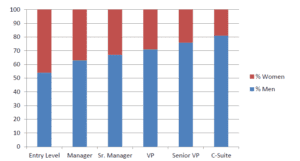 If you work for a large corporation, you’ve probably noticed how the general working population is a fair mix of men and women, but as you go up the corporate ladder, you find fewer and fewer women. It’s not your imagination. According to Women in the Workplace 2016, a recent study by McKinsey & Company and LeanIn.org, statistics demonstrate just how common this occurrence is.
If you work for a large corporation, you’ve probably noticed how the general working population is a fair mix of men and women, but as you go up the corporate ladder, you find fewer and fewer women. It’s not your imagination. According to Women in the Workplace 2016, a recent study by McKinsey & Company and LeanIn.org, statistics demonstrate just how common this occurrence is.
The study found that most women would never make their way to the top because women are less likely to be promoted to middle-management positions, such that there are fewer women in the pool of potential candidates for top jobs. This difference is especially pronounced for women of color, who face the most significant obstacles to advancement, with their numbers dropping off even more sharply at senior positions.
While public corporate approval of gender diversity has never been greater, that commitment isn’t trickling down to promotions into the higher ranks. The report concludes that to produce real change, employers need to establish gender diversity as a business imperative. How? By improving communication, increasing training, and focusing on results.
Report Shows Sharp Drop-Off in Numbers of Women as Management Levels Increase
The study was based on employment data and human-resources surveys from 132 companies, collectively employing more than 4.6 million people. Another 34,000 employees completed a separate survey, reporting their attitudes about gender, job satisfaction, ambition, and general work-life issues.
The highlights of the report include the following:
- Fewer women are promoted to managerial positions. Men were significantly more likely to be promoted to supervisory or managerial positions, with 130 men promoted for every 100 women. The total promotion rates are lower for women, especially with the very first promotion to a managerial position. This missing first step causes a domino effect: because fewer women are working in lower management, fewer are available for additional promotions, and far fewer end up at the top. (See the graph below for a visual representation of this decline.)

- Very few women have the opportunity to be promoted to CEO. Women represent just 20% of senior vice president roles—the roles that naturally lead to executive positions. In 2015, 90% of new CEOs in the S&P 500 had been promoted or hired from high-ranking roles.
- The entire playing field is uneven. Because female employees aren’t in managerial positions, they lack access to the mentors and opportunities that could help them advance their careers. They are therefore invisibly disadvantaged in their daily work interactions. Women tend to recognize this imbalance, believing that they lack the opportunities that men have for growth and development and that their gender plays a role in their odds for raises, promotions, or other chances to get ahead.
- Men are encouraged to negotiate, while women are discouraged from negotiating. Women who negotiate for promotions or pay increases are 30% more likely to be perceived as “bossy,” “too aggressive,” or more “intimidating” than men are.
- Senior leaders are less available for women. Employees understand that being “sponsored” by senior managers is a key to their career success, but women have fewer meaningful interactions with senior leaders than men do.
- Women and men seek feedback equally, but women don’t often receive it. The study showed a broad problem with communications. While both genders ask their supervisors for feedback, women report receiving informal feedback at a lower rate than men do.
- Women have less interest than men in top executive positions, taking a different view of the costs and benefits of senior leadership. Only 40% of women, compared to 56% of men, are interested in top executive positions. While both men and women report being concerned with work-life balance and company politics, women report feeling more discouraged by both the pressure accompanying top positions and the arduous and uncertain path to those positions.
Why Should Corporations Change Their Ways and Promote More Women Into Executive Roles?
1. Gender diversity is good for business.
Catalyst, a nonprofit seeking to bring more women into the workforce, found that Fortune 500 companies with more women in top management and advisory board positions had higher financial returns, according to the Huffington Post. Additionally, McKinsey reported that among publicly traded European companies, those that had higher levels of gender diversity among their leaders measured better on a variety of financial metrics, including returns on equity, operating profits, and stock prices.
Catalyst also reported that differences in leadership aren’t due to differences in availability: women make up almost half of the workforce and the available pool of candidates. Women today earn more degrees, both undergraduate and graduate, than men do. Businesses that want to employ and retain the most skilled and talented workforce available must seek out, support, and promote employees of both genders.
Research from Scientific American shows that socially diverse groups—such as companies with both males and females in management—are more innovative than more homogeneous groups. Not only does a variety of different types of people provide a similar variety of skill sets and knowledge, but the daily interactions among varied people also force everyone to see problems from different viewpoints and to appreciate the effort that it will take to reach an agreement.
2. Companies that avoid diversity may be breaking the law—regardless of whether they mean to.
State and federal laws prohibit employers from making promotion decisions based on employees’ sex. Companies know that they would break the law if they made promotion decisions based on an intentional bias against women, but it’s also illegal to promote candidates in a way that disparately affects females. You don’t have to show intentional discrimination to prove this kind of disparate impact, but you do need to show considerable facts and statistical analysis.
These cases generally boil down to a three-step inquiry:
- Does the employer use an employment practice that has a disparate impact on one sex? If an employee needs experience in a male-dominated department or job function to be promoted, the lack of that experience may disparately hinder female candidates.
- If the selection procedure has a disparate impact, can the employer show that the procedure is job-related and consistent with business necessity? An employer could show that a screening procedure is necessary to ensure the safe and efficient performance of the job. This practice should be associated with the specific skills and knowledge needed to perform the job and should accurately evaluate a candidate’s abilities as they relate to that specific promotion.
- If the employer shows that the selection procedure is job-related and consistent with business necessity, it’s the employee’s turn again. Can she show that there’s a less discriminatory alternative available? Is there another way to screen candidates that would be just as effective in predicting job performance without disproportionately excluding female candidates?
Disparate impact cases can be complex, lengthy, expensive, and difficult to win, but when they succeed, these types of cases benefit an entire class of people beyond just the individual plaintiff. When the overall promotion process is made fairer for women, all women stand to benefit—and so do the companies that employ them.
Summing It Up
If you’re a woman who’s been passed over for promotions and you feel like you’re losing out to less-qualified male candidates, you’re not alone!
- Statistics demonstrate that this is a common occurrence, originating with how corporations first promote their employees to managerial positions.
- If you have evidence that you weren’t promoted intentionally because of your sex, you may be able to prove that your employer broke the law.
- If instead you weren’t promoted based on a system of practices, policies, and procedures that caused an inherent, if not intentional, bias against female candidates, you may also have a case—but it will be harder to prove.
If you want to learn more about how anti-discrimination laws apply to promotions, or if you have questions about your particular situation, contact our office today. We can talk about your personal situation, help you understand the law, and advise you about your best options to protect your rights.




